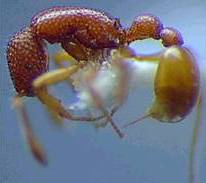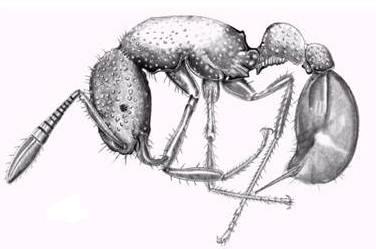
Муравьиные новости (2003 - №66)

***
"Insectes sociaux", Муравьиные НОВОСТИ: Виды-2005 и 2004,
Статьи-2005 и 2004
|
15-7-2005
|
|
Обнаружен ТИРАННОМИРМЕКС РЕКС
|
|
Fernando Fernandez
...
Profesor Asociado, Instituto de Ciencias Naturales, Universidad Nacional de Colombia, Bogota D.C., Colombia
A new myrmicine ant genus from Malaysia with uncertain affinities (Hymenoptera: Formicidae)
|
|

"Zootaxa", 2003, Volume 341: Pages: 1-6
|
|
|
Новый для науки (T. rex Fernandez,2003, n. sp.) и совершенно необычный вид муравьев обнаружен в Малайзии (Negri Sembilam). Профессор Колумбийского университета в Боготе Фернандо Фернандез, описавший его только по рабочей касте (самцы и самки не найдены), дал ему совершенно уникальное название - Tyrannomyrmex rex, напоминающее нам самого страшного динозавра-хищника Мезозойской эры - Тираннозавра рекса.
Главными отличиями нового вида являются мандибулы с 2-мя зубцами, внутренние модифицированные сеты на вентральном крае мандибул и мезосома, практически лишенная каких-либо швов и бороздок. Представитель подсемейства Myrmicinae.
Автор открытия выделил его в отдельный новый род и считает его вероятно близким к группе родов Adelomyrmex. Новый род особенно напоминает род Baracidris из Африки (особенно сетами - щетинками).
Однако, по признакам антенн и клипеуса, по количеству зубцов, структуре сет имеются и отличия от группы Adelomyrmex (у них сеты лопатовидные, а у Tyrannomyrmex rex - цилиндрические). Поэтому сходство это может быть конвергентным. Классификация этого подсемейства вызывает у мирмекологов самые большие затруднения. Поможет ли решению проблемы Тиранномирмекс?
Группа родов Adelomyrmex (2 рода и 26 видов с учетом 12 новых, описанных в 2003 году самим Фернандесом в его родовой ревизии, "Zootaxa", 2003, №361, pp.1-52): Adelomyrmex Emery, 1897 (более 20 таксонов из Индо-Австралии\Новая Гвинея, Фиджи, Самоа\ и Неотропики),
Baracidris Bolton, 1981 (2 вида - Афротропика: B.meketra Bolton,1981 из Нигерии и B.pilosa Fernandez,2003 из Кении и Габона).
Среди подсемейства Myrmicinae 2-зубчатые мандибулы известны только в двух родах: у современных африканских муравьев Afroxyidris (Belshaw & Bolton, 1994) и вымерших Oxyidris из Доминиканского янтаря (Wilson, 1985). Но это скорее конвергентное сходство. Род Afroxyidris ближе к Carebara и трибе Pheidologetonini, а род Oxyidris, по мнению Уилсона, близок к трибе Solenopsidini.
На нашем сайте Вы также можете обнаружить, что сходную с Тиранномирмексом формулу щупиков имеют ещё несколько родов.
2:2 - Aenictus, Carebara, Cerapachys, Dorylus, Indomyrma, Pheidologeton, Tyrannomyrmex, Vollenhovia, часть Eurhopalothrix и Rhopalothrix, Bothriomyrmex в Австралии,
3:2 или 2:2 - Pheidole,
1:2 или 2:2 - Amblyopone, Hypoponera, Monomorium.
Обзор подсемейства Myrmicinae
***
|
|
©2005, Владислав Красильников (перевод, комментарии). Всякое использование без согласования с автором и без активной гиперссылки на наш сайт преследуется в соответствии с Российским законодательством об охране авторских прав.
|
| |

Tyrannomyrmex rex (по: Fernandez, 2003)
(вид рабочего сбоку)
|
| |
|
ОПИСАНИЕ
ПРИЗНАКИ РОДА Tyrannomyrmex Fernandez, 2003
- Мандибулы только с 2 зубцами (апикальным и мелким субапикальным) на жевательном крае, который далее несет многочисленные тонкие цилиндрические сеты.
- Лобный валик и усиковые бороздки отсутствуют.
- Передний край клипеуса с одной медиальной сетой.
- Формула щупиков 2,2.
- Усики 11-члениковые с 3-члениковой неясной булавой, последний концевой членик в несколько раз крупнее остальных.
- Мезосома без швов и бороздок.
- Проподеальные дыхальца округлые
- Проподеальные доли крупные
- Жало крупное и твердое
ПРИЗНАКИ вида Tyrannomyrmex rex Fernandez, 2003
- Общая длина 3,75 мм.
- ПРОМЕРЫ: HW 0.60, HL 0.80, EL 0.06, SL 0.64, PrW 0.49, WL 1.06, PL 0.43, PPL 0.29, PW 0.29, PPW 0.31, GL 0.92, TL 3.75, CI 75, SI 106.
- Голова чуть длиннее своей ширины с округлыми задними краями, бока и задний край слегка выпуклые.
- Тело светло коричневое.
Tyrannomyrmex rex Fernandez, 2003
Голотип единственной рабочей особи найден в Малайзии, Negri Sembilan; Pasoh Forest Reserve, litter sample, xi.1994, M.Bernardi, M.Jackson & S.Lewis legg No.312.
Место хранения материала: Natural History Museum (BMNH), London, UK.

Tyrannomyrmex rex (по: Fernandez, 2003)
(вид рабочего сбоку)
|
| |
|
Tyrannomyrmex rex new species
ПРОМЕРЫ РАБОЧЕГО: HW 0.60 HL 0.80 EL 0.06 SL 0.64 PrW 0.49 WL 1.06 PL 0.43 PPL 0.29 PW 0.29 PPW 0.31 GL 0.92 TL 3.75 CI 75 SI 106.
ОПИСАНИЕ РАБОЧЕГО: Head in full face view longer than wide, with rounded posterolateral corners, and slightly concave posterior margin; sides slightly convex, slightly narrowing anteriorly. Basal mandibular border separated from masticatory border by distinct angle, masticatory border mostly edentate except for two apical teeth, ventral border of masticatory margin with row of thick, modified setae. Palp formula 2,2 in situ count. Anterior margin of clypeus convex, nearly angular medially; posteriorly clypeus projects narrowly between frontal lobes; median portion of clypeus raised and convex in lateral view, not modified as a flattened area and devoid of any carinae. Frontal lobes short and approximate. Antennae 11-segmented, with ill-defined 3-segmented club, the apical segment largest; scapes longer than head width, slightly incrassate subapically. Scape, when placed back, fails to reach the vertex margin by less than its maximum diameter. Eyes small, with a few ill-defined facets (about 6-7), situated slightly anterior to midlength of sides of head. Mesosoma forming a single broad and continuous convexity in lateral view, devoid of any grooves; propodeum armed with two small triangular teeth, propodeal spiracle round and at distance from propodeal margin equivalent to three diameters. Metapleural lobes broad, more or less rounded. Metapleural gland orifice not seen at 120X. Petiole large and prominent, campaniform in lateral view, in dorsal view the node longer than wide; postpetiole more or less as long as wide. Body shining and heavily foveolate, except for the smooth gaster. Most head foveae dense, about 70% of the eye size; those of mesosoma scattered and smaller in size. Body lacking pilosity, except for numerous small erect hairs arising from the cephalic foveae and anterior pronotal region; a few erect hairs on propleura and forecoxa; anterior margin of clypeus with long erect hairs, including a distinct medial seta. Dorsum of mandible, scape and flagellomeres with several erect hairs. Inner ventral margin of masticatory border of mandibles with modified thick, cylindric and transparent setae. Body light brown in color.
ГОЛОТИП РАБОЧЕГО: Malaysia, Negri Sembilan; Pasoh Forest Reserve, litter sample, xi.1994, M. Brendell, M. Jackson & S. Lewis legg No. 312. Deposited in the Natural History Museum (BMNH), London, UK.
САМКИ И САМЦЫ: не обнаружены.
РАСПРОСТРАНЕНИЕ. Known only from type locality in Negri Sembilan, Malaysia.
ДИСКУССИЯ: Reliable placement of most genera within Myrmicinae, including the genus described here, is difficult, given the precarious state of current understanding of the phylogeny and taxonomy of the subfamily. Tyrannomyrmex possesses a unique combination of traits which separate it from other myrmicines: modified setae along the internal border of the mandibles and mandibles with two teeth, apical and subapical, with the rest of the masticatory border lacking teeth. The modified setae are reminiscent of some of the Adelomyrmex (Fernandez, 2003), but in Tyrannomyrmex the setae are thick, nonspatulate, and cylindric. A detailed SEM examination is impossible at the moment due to lack of more specimens than the holotype.
The antennal club is not easily-defined. At first glance it appears to be 2-segmented, but the last segments under careful examination might also be interpreted as 3-segmented.
Including Tyrannomyrmex in Adelomyrmex genus-group would make it difficult to explain the traits the genus does not share with the tribe, such as the antennal configuration of 11 with ill defined club of 3 segments compared with 12 with club of 2 segments in Adelomyrmex genus-group and simple clypeal configuration, without elevated platforms, keels or carinae as in Adelomyrmex genus-group. The petiole is different in shape from the adelomyrmecines and the transverse, subpostpetiolar keel, which is unambiguously in an anterior position in the tribe, is relatively shorter and more medial in Tyrannomyrmex. Notoriously absent in this genus as well are dorsal mesosomal grooves, whilst in adelomyrmecines the metanotal groove is always present.
If Tyrannomyrmex were an adelomyrmecine genus, some of its structures could be interpreted as reductions (antennae from 12 to 11 segments, mandibular teeth from 4-7 to 2, disappearance of the metanotal groove, changed configuration of the petiole and ventral keel of the postpetiole. It would be necessary to accept a double modification of the structure of the clypeus from simple to modified to a keel or longitudinal platform (Adelomyrmex genus-group) and then back again to simple in form (Tyrannomyrmex).
The characteristics shared in both taxa, such as reduced palps and groove in the basalmost anterior part of the first tergum might be considered plesiomorphic characters within the Adelomyrmex genus-group, Tyrannomyrmex, and some neighboring groups, perhaps Solenopsidini and Pheidologetonini. Tyrannomyrmex could be interpreted as a basal taxon in the Adelomyrmex , genus-group (or a sister group of the tribe), implying that the modified setae are homologous in both groups.
Given that Tyrannomyrmex has a medial clypeal seta, there is a possibility that it might be near to Solenopsidini. In effect, Tyrannomyrmex possesses the majority of this tribe's attributes according to Bolton's (1987) proposal, but the metapleural lobes are large and conspicuous in Tyrannomyrmex, while they are fairly reduced in Solenopsidini. Moreover, within Solenopsidini only Phacota has 11 segmented antenna with club of 2 segments configuration, though it is important to keep in mind Phacota appears to be based on an anomalous specimen, perhaps an ergatoid reproductive (Bolton, 1987), and is probably another member of Monomorium.
Within the Myrmicinae bidentate mandibles are known only in Afroxyidris, an African species (Belshaw & Bolton, 1994), and Oxyidris, described from Dominican amber (Wilson, 1985). Afroxyidris appears to be near the group of genera associated with Carebara (Fernandez in preparation) in the tribe Pheidologetonini. The position of Oxyidris is more uncertain as even though Wilson (1985) places it near Solenopsidini, the genus lacks a median clypeal seta. I therefore do not consider Tyrannomyrmex to be near either of these genera; the possession of 2-toothed mandibles appears rather to be convergent in the three groups.
For all these reasons Tyrannomyrmex should be considered for the moment as a distinct but isolated genus of the subfamily, whose affinities might be with either the Adelomyrmex genus-group or with Solenopsidini. A detailed micrographic study might make possible a better interpretation of the structure of the modified setae of the internal part of the mandibles, the only character which might, potentially, place the genus within or near the Adelomyrmex genus-group.
|
|
|
| |
|
©2005, Vladislav Krasilnikov (translation & supplement)
|
|
Всякое использование без согласования с автором и без активной гиперссылки на наш сайт преследуется в соответствии с Российским законодательством об охране авторских прав.
|
|



